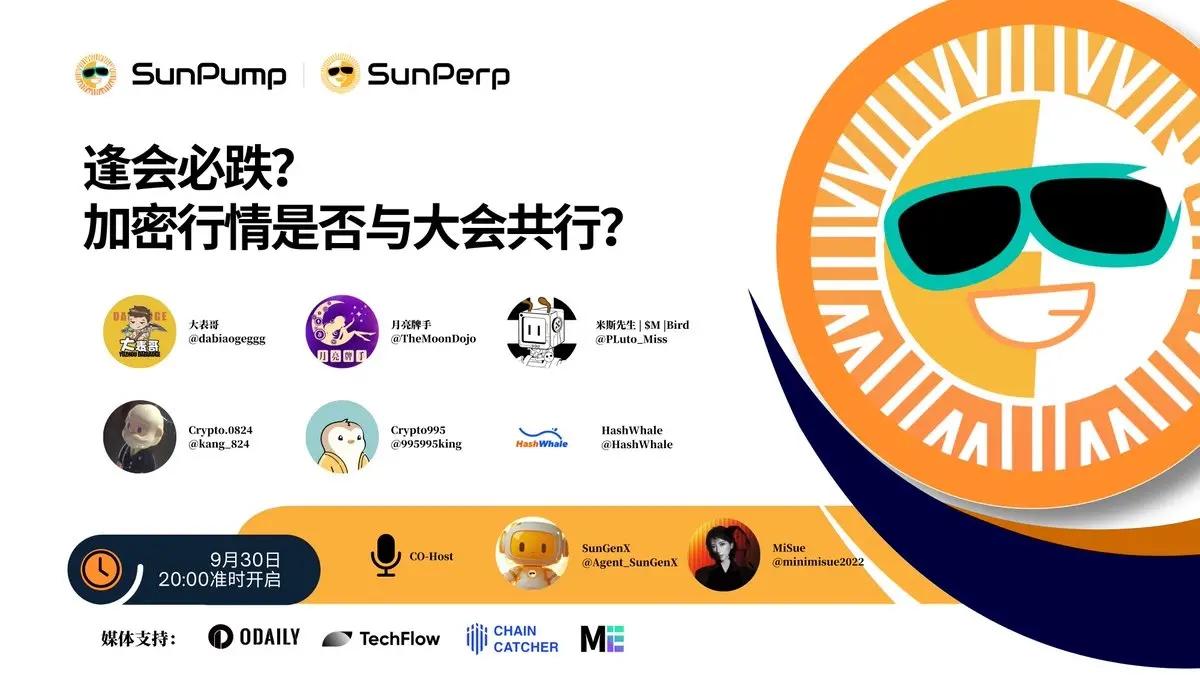Whenever blockchain industry events such as Token2049 come, the curse of "falling every time there is a meeting" is like a sword hanging high, making every holder vigilant.
From A-shares to cryptocurrencies, this phenomenon seems to have become a common memory across markets. When the agendas of policy summits and industry forums are announced, market capital often chooses to wait and see or even cash out early, as if the meeting itself has become the trigger for price fluctuations.
In stark contrast to the "consistent decline" in every conference, mainstream blockchain projects actively participate in conferences, viewing them as an excellent platform to showcase their strengths and expand collaboration. For project developers, conferences can be both a "risk window" and a "starting point of opportunity."
So, is the "consequential decline at every conference" a market coincidence or an inevitable trend? How do capital flows and ecosystem narratives during conferences jointly influence market trends? Perhaps the real question is how to grasp this rhythm. This issue of Space invites several industry KOLs to delve into the complex relationship between the crypto market and industry conferences, uncovering the underlying principles. The following is a recap of this issue.

There will be a fall every time there is a meeting. Is it a market coincidence or an inevitable law?
Crypto.0824 believes the phenomenon of "market crashes at every conference" is more a result of psychological factors. "It's like the stock market's 'poor May, desperate June, and a turnaround in July'. It's not a scientific law in itself, but everyone believes it, and it happens." He points out the key mechanism: "Before the conference, everyone was saying the market would fall, so a lot of funds were cashed out early to avoid risk, and the market actually fell." However, he also points out that this pattern is not unbreakable. "During the 2021 Bitcoin bull market, celebrities at the conference released a series of positive news, which actually pushed the market up."
Crypto995 analyzed this psychological mechanism from a more professional perspective: "This is similar to the 'buy expectations, sell facts' principle in traditional finance. Good news is often hyped up in advance, and prices already factor in expectations. By the time the conference arrives, investors worry that all the good news has faded, and they choose to take profits."
Despite their differing perspectives, the panelists seemed to reach a consensus: "Every conference leads to a decline" isn't an ironclad market rule . Crypto995 noted, "If we take a longer-term view, the true market dynamics are still driven by the macro environment." Mr. Miss also believed, "When liquidity is sufficient, conferences aren't necessarily linked to price fluctuations."
In a subsequent discussion, Moon Player offered a vivid analogy: "Conferences are like megaphones for narratives. They don't create market trends, but they amplify them." This amplifying effect allows existing market sentiment to be concentrated and released at specific moments. The market doesn't simply repeat history, but it always follows similar patterns. Understanding the mechanisms behind the "consequential decline at every conference" phenomenon may help us make more rational decisions when the next major industry event arrives.
The Capital Game and TRON's Ecosystem Layout Under the Conference Narrative
While market participants debate the phenomenon of "market crashes at every conference," industry leaders remain actively engaged in global dialogue. During the Token 2049 conference, TRON, as a core participant, was deeply involved in various conference proceedings, showcasing its technological progress and ecosystem layout to the global market through keynote speeches, ecosystem events, and themed side events. This active participation demonstrates that for projects truly committed to long-term development, industry events are no longer just amplification of short-term sentiment, but rather strategic opportunities for ecosystem development.
TRON demonstrated tangible ecosystem achievements at the conference. Its average daily network transactions consistently lead the industry, and TRC-20 USDT issuance consistently commands half of the market share. Regarding financial performance, TRONSCAN data shows that TRON's ecosystem protocol revenue exceeded $3.61 billion over the past year, with nearly $1 billion in revenue achieved for two consecutive quarters in the first half of 2025 , setting a new record . These solid figures provide compelling evidence of TRON's ecosystem and technological strength.
Of particular note, five key projects within the TRON ecosystem—SunPump, JUST, APENFT, BitTorrent, and WINkLink—made their collective debut at the conference, covering key sectors such as DeFi, Meme, NFT, cross-chain infrastructure, decentralized storage, and oracles . This collective showcase not only demonstrated the prosperity of the TRON ecosystem but also sent a clear signal to the market: true ecological value comes from coordinated development at multiple levels and in multiple fields.
HashWhale mentioned in the discussion: "After the conference, the market will enter a 'true and false trend screening period.' Only those tracks with real application scenarios and technical barriers can survive cyclical fluctuations and achieve sustained growth." The multiple ecological projects highlighted by TRON precisely meet this characteristic.
Through a series of actions during the conference, the TRON ecosystem not only demonstrated its technological strength but also built a broad network of partners. The effects of these initiatives won't be immediately apparent, but they will sow the seeds for future value growth.
As the Moon Player said, "We have to ask ourselves, is the content released at the conference just a gimmick, or can it generate real revenue or cash flow?" The TRON ecosystem has given the answer with practical actions - real value creation requires time to be verified, not just a short-lived highlight during the conference.







